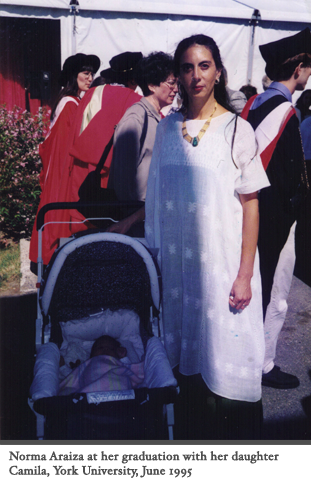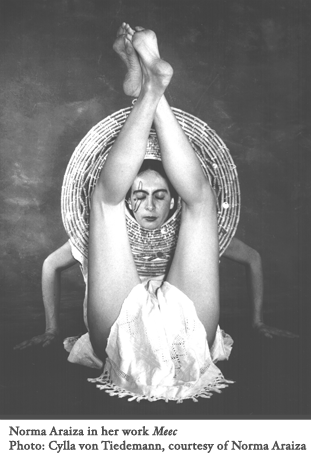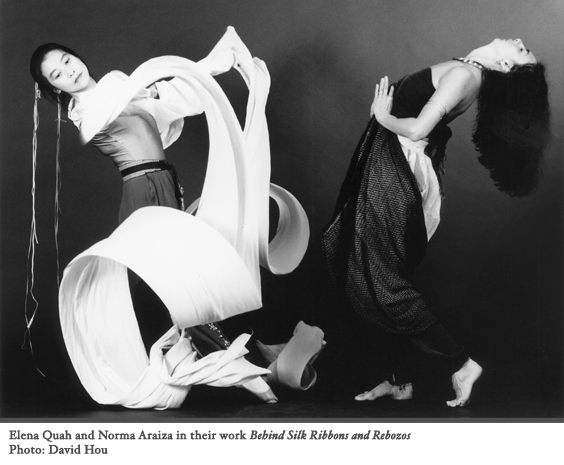| 
next page l previous page  NA: Now, yes I think so, but at that time, this feeling of not fitting contributed to me not performing and creating more … On the other hand, I got calls from the Native Centre, from the McMichael Gallery, from the AGO to perform this kind of work. But the dance community was a little reticent. NA: Now, yes I think so, but at that time, this feeling of not fitting contributed to me not performing and creating more … On the other hand, I got calls from the Native Centre, from the McMichael Gallery, from the AGO to perform this kind of work. But the dance community was a little reticent.
CA: Well, Toronto has always seemed more a company town, where independents have to find a place …NA: I dreamed of having my own company, and I do in a way, but never like Dancemakers or TDT or the Kaejas. It was difficult for me to do it. CA: It makes a claim on all your energies.NA: Yes, and it has to do with your choices – I decided to have a family and that is the most amazing thing I've experienced. I have one daughter; I decided to be a mom. So even though I never left it, I didn't dedicate myself 100 per cent to dance. I started teaching – I was always petrified about teaching, first because of my English. When I was a teaching assistant, doing my Master's, and had to say something to a class, I would become like fire – red red red – because the students sometimes didn't understand my accent. When Nina De Shane gave Zelma and I the opportunity to teach, it was very difficult, but also a good exercise. I realized I was good at teaching, if I do say so myself – probably a better teacher than a dancer! I teach Indigenous Dance Theatre at Trent University now. I love it! I think because I'm so passionate about it, I can do it very well. I can listen to the students' needs – it's the back and forth with the students that I really like. That's another aspect of my professional development as an artist. I have done a lot of coaching. And because of my theatre background, I work a lot more in the theatre community coaching movement. CA: It's interesting – you've found ways to combine your professional practice with a component that's not strictly academic, but delves into the cultural significance and context of your work. NA: Because of the approach I trained with, I see life in a holistic way – I definitely try to live my life the way I teach, the way I choreograph, the way I dance. One informs the other. That's my intention. When I teach, I share some of my ethnic background, who I am as a person, what I do, and that comes across. CA: Were you part of the Banff Aboriginal Dance program? Is that where you met Marrie Mumford?NA: No – I met Marrie after her time in Banff. I've always been kind of slow finding things out (laughs); when she was there I knew about the program, and I knew Alejandro was there – but it never occurred to me that I would be eligible, because I thought only pure indigenous people were admitted. But also there was a part of me that was insecure in terms of my heritage, and who I was. Now, I'm very clear, but before I was not, because I was discovering it myself. It was a tough time for me in terms of my identity. People saw me as Mexican or Latina. The indigenous part of me was always very quiet, on the back burner. I always felt, no, I'm not indigenous enough … Little by little I've been realizing there's a lot I can get out and it's never too late. I'm still working on it. But now – I'm out of the closet!  CA: I'm wondering if you might talk about your work as an expression of your journey toward uncovering your identity … through your teaching or in some of the pieces you've made CA: I'm wondering if you might talk about your work as an expression of your journey toward uncovering your identity … through your teaching or in some of the pieces you've made
NA: I think the pieces I've done all have a common denominator – they all have something of that search for identity. Even though the theme, in itself, is not identity, they have that. The first one – Chamana Woman of All Times – the piece I was talking about, with the mask, was my first attempt to say: this is inspired by, but also part of, me. Maybe I'm that shaman … many of the dance pieces I've done are based on, or inspired by indigenous legends, traditional Mexican legends, such as the Day of the Dead – a celebration that has a very specific, very particular character named La Catrina who represents death. I did a piece about that. Then Meec, which means “moon”, that was inspired by an Aztec legend; it also talks about femininity – the feminine part of myself I always criticize. My pieces contain this part of me, looking for who I am, or re-affirming myself. Now I'm developing a piece inspired by de-colonization, inspired by La Malinche, Cortés's lover; she was his translator, but also gave birth to their two sons, who were the first Mestizos in the world. This thing of being part Spanish and part indigenous – a lot of Mexicans are, a lot of Latin Americans are – but some go more toward European culture, others more toward the indigenous, as I did. My brother and I went this way and my two other sisters went the other way. It's interesting – my brother and I keep our hair just the way it is, my sisters dye their hair … my mom continues dying her hair. She wears more Western clothing. I go back and forth, but I have a lot of traditional dresses, and always you'll see me with something that suggests that background. I have this anthropological approach – it's always coming from me – it's my interpretation, my feeling … I try to make it universal, but sometimes it's very much me. CA: Who are your students and what are your teaching methods at Trent? NA: My Indigenous Dance Theatre course has students in third and fourth year, from all over the campus. While in every class I have two or three people with indigenous backgrounds, most of them do not, though all are students of indigenous studies. Every year is different. I have a syllabus, but I change topics every year, as I research different things. I always use the course as a lab. I teach in the winter term. Last year I did Animal Medicine. So we delved into an animal that each student felt very attracted to and really incorporated that animal's physicality. The physicality is the training, but also the physical transformation and storytelling. “Tell me a story,” I say, “about this creature – who is he or she? What do they do?” The expression is always through dance theatre. A lot of the training is based on what I learned from Grotowski and Barba. When I was hired, I actually asked Marrie, my boss, if it was okay that I was incorporating Western approaches. She said, “Yes, because we are in a Western society.” It's the spirit of that indigenous cosmology that comes into the class, in the topic, in the way you approach things – even if you are using Western techniques. So I feel very much at home there.  This year I started working with my students on de-colonization, based on La Malinche, and also the feathered serpent; the serpent as the shedding – the mythological serpent of transformation, rebirth, which appears in many other cultures, not only indigenous or Mexican. We did research and translated it into our bodies. I created a whole warm-up for the spine with the serpent in every part of the body. Again, storytelling – the indigenous way of putting storytelling, music, drama and dance together into one. At the end, we had a presentation. This year I started working with my students on de-colonization, based on La Malinche, and also the feathered serpent; the serpent as the shedding – the mythological serpent of transformation, rebirth, which appears in many other cultures, not only indigenous or Mexican. We did research and translated it into our bodies. I created a whole warm-up for the spine with the serpent in every part of the body. Again, storytelling – the indigenous way of putting storytelling, music, drama and dance together into one. At the end, we had a presentation.
Every year is different. I use the process to research areas I'm interested in – and the students respond really well. CA: Can you comment on how you see yourself and your work in the context of Canadian dance and dance theatre?NA: Right now I see myself pretty much integrated into that milieu. Even though I am not as active as I would like to be in terms of producing a lot of dance pieces or “getting out there,” I'm quietly doing my work. But I feel integrated because I know many people; I have worked with a number of people here and there, have worked on collaborations – I feel part of the mosaic. I don't have a feeling of being separated or ostracized. I used to, but not anymore, because I feel that it depends on me. In the past, my own insecurities didn't allow me to just offer what I had. I feel I am contributing. I have a very particular style. Also, I feel I'm moving into a different part of my life. My daughter's going to university now. I ended a relationship of thirteen years, just recently. I'm in a complete transition. Shedding. I'm in this transformation – so it's coming out again as rebirth in this piece that I'm doing. The theme allows me to get more into what I always wanted to do fully, but chose not to because I had a family, I had another job … So I feel part of dance, even though I am not as active as I would like to be. But I am still working in the field. CA: Can you comment about how things have changed to become more inclusive, or not? There was a lot of activity when you arrived, but the validation and valuing was just beginning to change … NA: To be honest, I think there's still a long way to go. I don't think – at least in Toronto – we can say that dance professionals who come from another country are fully integrated. I don't think so. But I have realized, in my older age, that it depends on what I am doing to get myself integrated. It takes two to tango; I have to do my part. I feel it has changed – all the arts councils are definitely more accepting of different dance forms and approaches. I have gotten quite a few grants from various agencies. Yet – I had a bad experience with Canada Council recently; they said I am not an indigenous person from this country, so I cannot apply for indigenous funding. I was doing a project in Mexico and applied for a travel grant. They sent me to another office. Even though I'm a Canadian citizen … So – it's still happening, but it's less. I feel that as I've become more comfortable with who I am and what I have to offer – and I don't really care any more if people like it or not – then transformation happens. 
Yes, there are a lot of misunderstandings still. I was talking to [former dance writer] Rebecca Todd one day – I did a collaboration with Elena Quah a few years ago and Rebecca came to the studio to do an interview. She asked me why I was not doing more collaborations with mainstream dance artists. I said, “Because they don't invite me.” She said, “Well, I always thought you did not want to work with them.” I was amazed. It is a misunderstanding, and an assumption, because I would love to collaborate with mainstream artists, with other artists period – it's not that I want to stay in the background. Not at all. But because I do a specific type of dance, people think I might not be able to do the other. (next page) | |

